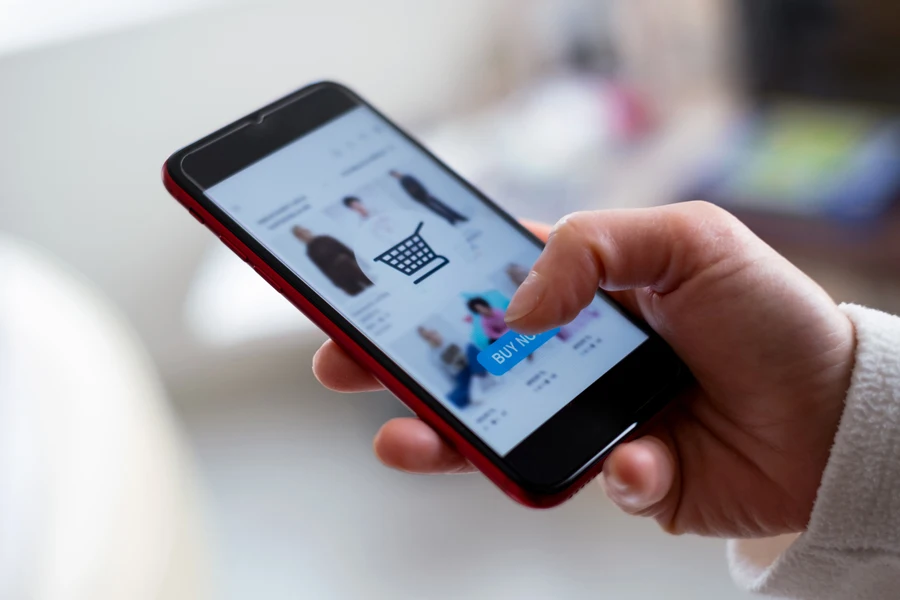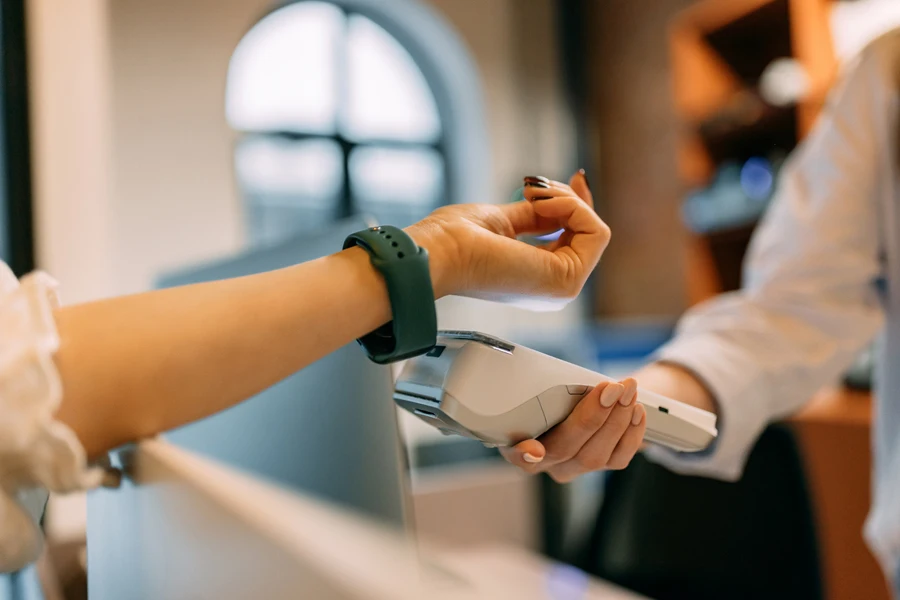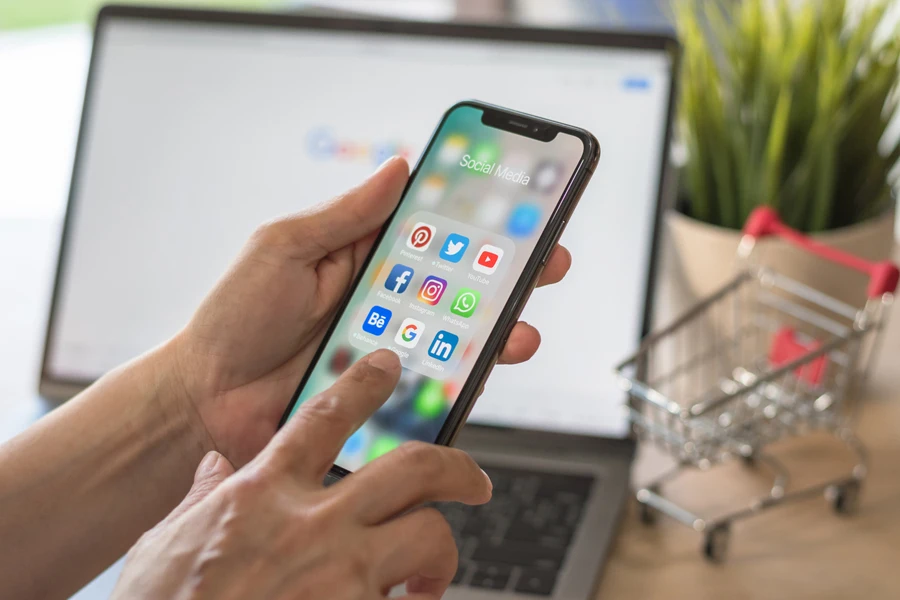Mobile commerce is changing how consumers shop, and business owners are aware. By 2024, over 70% of e-commerce sales are expected to come from mobile devices. Therefore, as a retailer, you need to keep up with the latest mobile commerce trends to stay ahead of the competition and keep customers engaged.
From artificial intelligence to voice commerce, here are the top mobile commerce trends to transform retail in 2024. Before diving in, let’s look at an overview of the mobile commerce market.
Table of Contents
Global mobile commerce market overview
Significance of mobile commerce
Top 5 mobile commerce trends to look out for in 2024
Conclusion
Global mobile commerce market overview
The overall direction of mobile commerce is on the upside as market experts predict the market size will have grown by 62% to reach US $3.4 trillion by 2027 from US $982 billion in 2018. In 2023, global mobile commerce sales grossed US $2.2 trillion, and the figures are projected to hit US $2.5 trillion by 2024, according to Statista.
This follows the fact that 55% of consumers who spend most of their time on smartphones and tablets more than any other device are seeing the convenience of browsing and shopping through these gadgets. Therefore, in 2024, brands need to optimize their entire customer journey for an advanced m-commerce experience to reap big benefits from mobile shopping.
Significance of mobile commerce

Mobile commerce offers several benefits, not just to businesses but also to consumers. For businesses, m-commerce provides access to customers anytime and anywhere. Since most people have their phones constantly, retailers can connect with them on the go and drive more sales. In addition, mobile commerce allows for targeted, personalized marketing to customers based on location, buying history, and more.
For customers, m-commerce means convenience and savings. Buyers can shop from anywhere using their mobile devices, compare prices from multiple stores simultaneously, and, in some cases, even complete purchases faster than in traditional stores. Many online retailers also provide mobile-exclusive discounts and offers for their customers.
Top 5 mobile commerce trends to look out for in 2024
1. Voice commerce comes of age

Voice commerce is poised to change how business is conducted in 2024 and beyond. As smart speakers and voice assistants become more sophisticated and widely adopted, voice shopping is emerging as a convenient new way for customers to browse and buy products online.
By 2026, the voice commerce market will be worth US $55.68 billion. While still a fraction of the total retail revenue, this represents a massive opportunity for retailers and brands. You’ll want to optimize your customer experience for voice search and voice-enabled transactions to stay ahead of the curve.
Key trends to prepare for in voice commerce include:
- Voice product search: 40% of people use voice commands daily. In addition, 71% of consumers prefer voice-activated inquiries instead of typing. Therefore, you need to optimize your product data, images, and content for voice search results.
- Smart speaker shopping: A PWC study found that 40% of millennials have utilized voice assistant devices like Amazon Echo and Google Home to buy products. Another survey by Voicebot.ai revealed that 26% of smart speaker owners have made a purchase using the device, and 11.5% make purchases monthly. Thus, it is crucial to enable your products and payment processes for major voice platforms.

- Conversational commerce: Chatbots and voice assistants will handle more of the browsing and buying process; hence, you need to build conversational interfaces to guide customers through your sales funnel. Companies like Sephora have adopted an AI virtual assistant that brings their in-store experience to online shoppers. Using Generative AI has resulted in more than 332,000 conversation sessions and increased their monthly income by US $30,000 each month.
- Voice payments: Voice-activated payments through platforms like Amazon Pay, Google Pay, and Apple Pay will become popular. You can capitalize on this trend by ensuring your payment methods accept these new ways to pay by voice authorization.
2. Virtual reality/augmented reality

Virtual and augmented reality will transform online shopping experiences, allowing customers to make more informed purchases. A report by Deloitte revealed that by 2025, 4.3 billion customers will use AR/VR technology more often globally, up from 1.5 billion in 2021.
Also called AR, augmented reality lets one view virtual products in a real-world environment using a smartphone camera. Many retailers are already offering AR technology on their apps. Take the example of Zara or H&M, which use augmented reality on their apps to help online buyers try clothes before they buy, or Adidas and Nike, which assist shoppers in checking out sneakers before making their purchase decision.

Virtual reality (VR), on the other hand, immerses shoppers in a simulated world using a headset. Stores like IKEA are experimenting with VR shopping, where customers can browse virtual store shelves, get recommendations from a virtual sales assistant, and even make purchases with the VR experience.
While still emerging, VR and AR have a huge potential to reduce returns, increase customer satisfaction, and drive more sales. As a retailer, offering interactive digital shopping experiences can build brand loyalty and turn browsers into buyers. Being an early adopter is also a way to help your business stand out in a highly competitive market.
3. Seamless omnichannel experiences

Customers expect their journey to flow easily between devices and channels as mobile commerce grows. In 2024, the power of artificial intelligence and machine learning will connect e-commerce sites, mobile apps, and physical stores into one seamless shopping experience.
For instance, expect browsing history and purchases to follow mobile users across channels so that they can receive consistent recommendations and services no matter how they shop. In-store associates will also have a holistic view of shoppers’ past interactions to provide buyers with hyper-personalized services.
In addition, carts won’t be limited to a single channel. Customers can start an order via phone, add items on the website, and check out in-store if they prefer. Every step of the journey will be synced in real-time, enabling them to shop freely across channels without disrupting their cart or missing out on promotions.
Enhanced fulfillment will also take center stage next year. Flexible fulfillment options will let customers shop online and pick up in-store or ship to their home. Inventory visibility across the supply chain will make more items available for fast, free shipping or same-day delivery, depending on a customer’s needs.
By shifting from a single channel and unifying data operations, inventory, and operations across different channels, you can transform disconnected touchpoints into a seamless brand experience. The result is an increase in your m-commerce sales revenue. It’s why brands like Target implement an omnichannel marketing strategy, which saw their sales income skyrocket by 24.3%.
4. Advanced payment systems for mobile

Mobile payment systems are evolving rapidly, enabling more convenient and secure commerce experiences. In 2024, there will be significant strides in the following:
- Biometric authentication: Biometric authentication, like facial recognition and fingerprint or retina scanning, will become mainstream for mobile payments. These methods are more secure and convenient, allowing customers to authorize payments by scanning their face or finger using their digital devices.
- Contactless payment: Tap-to-pay systems let buyers pay without swiping or inserting a card. They use near-field communication (NFC) technology, which allows one to tap their phone or payment card on a payment terminal to authorize payment. Contactless payments are fast, hygienic, and secure. Adoption will surge as more payment terminals support NFC and more customers prefer touchless checkout.
- Invisible payments: Invisible payments use smart sensors, biometrics, and other technology to authorize payments invisibly in the background. For example, a coffee shop may have sensors that recognize a buyer when they walk in and charge them through their preferred payment method when they leave with their drink. Prominent market leaders like Uber, Amazon, and Starbucks are leading the way with this payment method. Invisible payments provide an ultra-convenient experience while still keeping financial data secure.
5. Dominance of social commerce

Social commerce, which incorporates social networks into the shopping experience, is set to dominate m-commerce in 2024. The power of social proof is one of the ways mobile commerce will boom in the years to come.
As people see their friends post about their latest purchases on social media, it makes them more inclined to buy those same items. Seeing others enjoy a product or service gives social proof that they’ll probably like it too. Brands are now tapping into this behavior by making shoppable posts and stories on platforms like Instagram and Facebook.
Social commerce will also help transform retail, thanks to ad retargeting. Customer activity and interests on social media provide data to target customers with specific product ads. For example, if a brand knows a customer bought a fitness tracker, they may show them ads for fitness clothes. Targeted ads like these are 76% more clickable than generic ones, which results in higher conversion rates and more sales.
It is a win-win for both retailers and consumers; the more people share about brands and buying on social media, the more mobile commerce will grow.
Conclusion
The trends discussed in this article are poised to shape how businesses conduct their retail activities in 2024 and in the years to come. Brands that don’t adapt to these trends will get left behind as consumers flock to online businesses offering the latest technologies and shopping experiences.
Are you ready to offer seamless mobile shopping experiences to your customers? Start today by sourcing products from Chovm.com.




